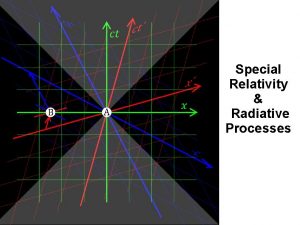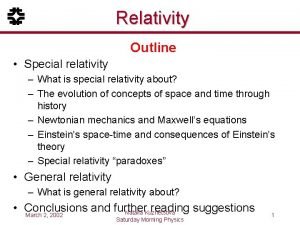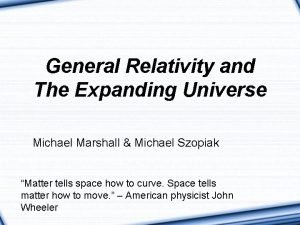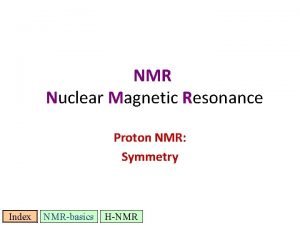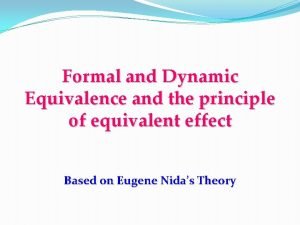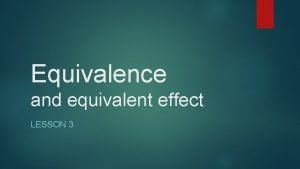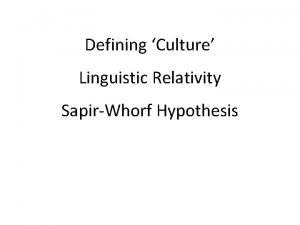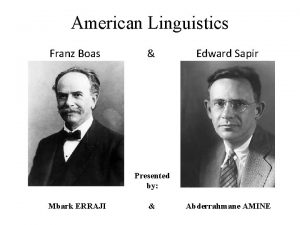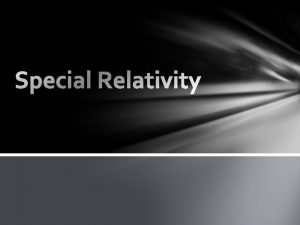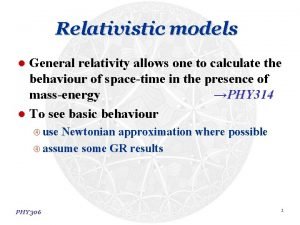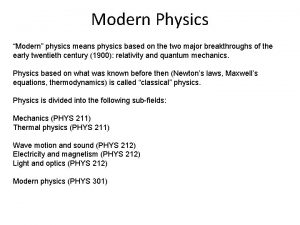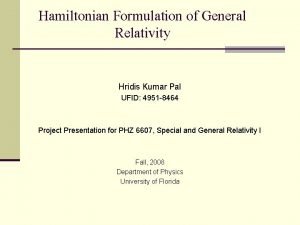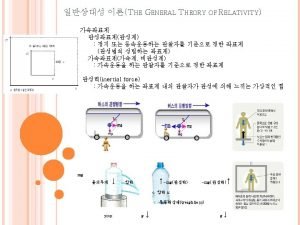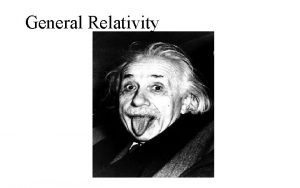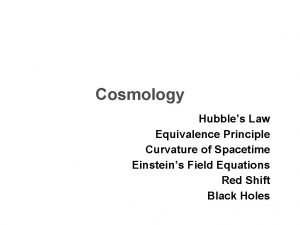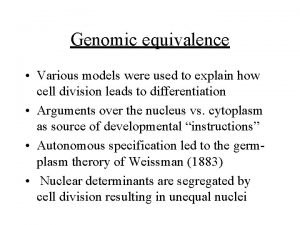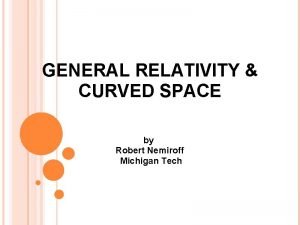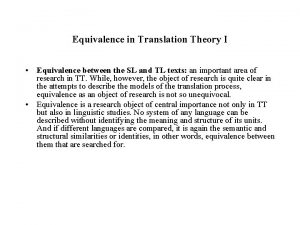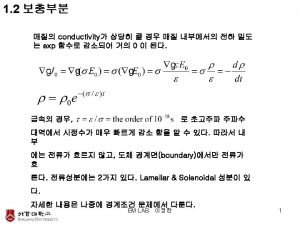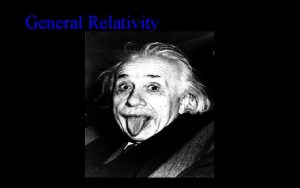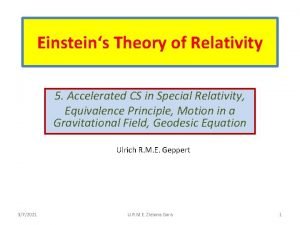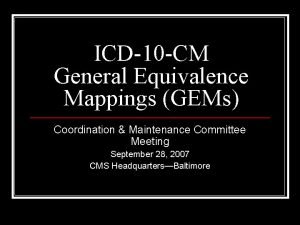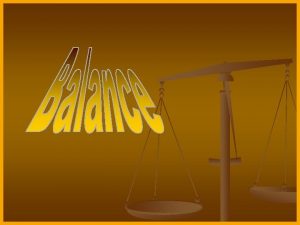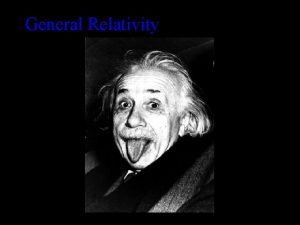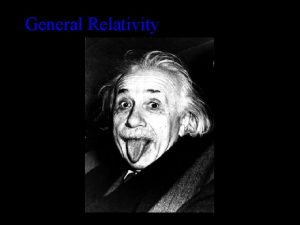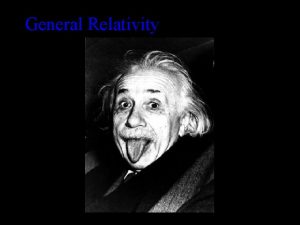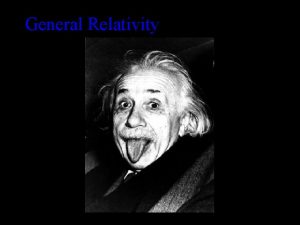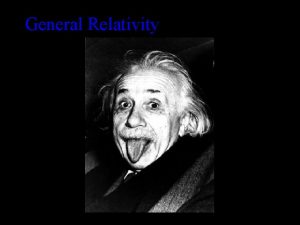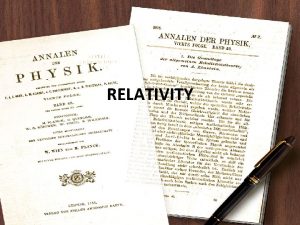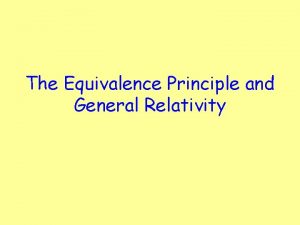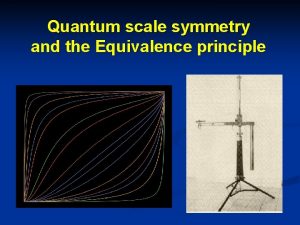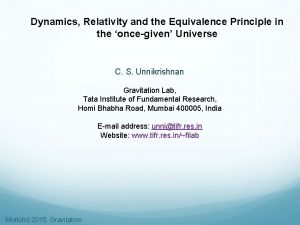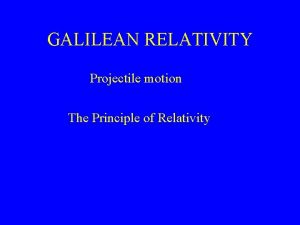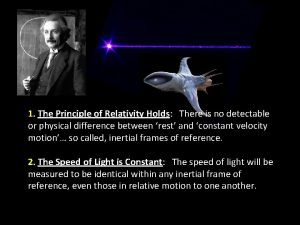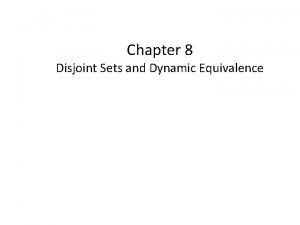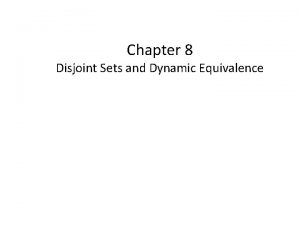General Relativity General Relativity Principle of equivalence There





























- Slides: 29

General Relativity

General Relativity Principle of equivalence: There is no experiment that will discern the difference between the effect of gravity and the effect of acceleration. Or… Gravitational and inertial mass are equivalent.

Principle of equivalence: On Earth: In space: a = 9. 8 m/s/s

Principle of equivalence: You feel Zero “g”s in free fall

Apparent Curvature of light: Not accelerating Accelerating up so fast the lady’s a goner

Apparent Curvature of light: In 1919, Sir Arthur Eddington Eclipse Light was bent twice as much as Newton’s theory predicted, supporting General Relativity

Gravitational Lensing:

Gravitational Lensing:

Curvature of Space: Now that you understand that gravity bends light… Understand that it does not. Light travels in a straight line. The space itself near a massive object is curved. Light is the absolute. It travels at the speed of light. It travels in a straight line. Do not adjust your television set… Re-adjust your brain.

Curvature of Space: Mass distorts space Analogy for dimensions …

Curvature of Space: Geometry is Non-Euclidian Were the sphere large enough… Riemann and Einstein… (Science itself)

Black Holes: Light cannot escape…

Black Holes: Gravitational Potential per unit mass: V = -GM r so PE = Vm At escape velocity, kinetic = potential 1/ 2 = GMm substituting c for v: mv 2 r r = 2 GM where r is the Schwarzschild radius c 2

Black Holes: Black Holes become so by getting smaller As r gets smaller, v gets bigger, when v = c it is a black hole Were the Earth 0. 35” in radius it would be a black hole The sun would be 1. 9 miles in radius. The sun and the earth will never become black holes. Not all by themselves…

Put this in your notes: What is the maximum radius of a black hole that is 30. million times the mass of the sun? Msun = 1. 99 x 1030 kg r = 2*6. 67 E-11*30 E 6*1. 99 E 30/3 E 82 = 8. 848866 x 1010 m = 8. 8 x 1010 m (More than half an AU!) 8. 8 x 1010 m

What is the mass of a black hole the size of the earth? 6 r = 6. 38 x 10 m M = rc 2/(2 G) = 6. 38 E 6*3 E 82/(2*6. 67 E-11) = 4. 3 E 33 kg

Clocks and gravitation: General relativity predicts that clock A will run faster than clock B… From Feynman Lectures in Physics

Clocks and gravitation: • Ship accelerating up • Observer at bottom of ship • Clocks emit pulses of light • Pulse 1 goes distance L 1 • Pulse 2 goes distance L 2 • L 2 is shorter than L 1 • Observer sees ticks closer together in time. • If it always appears to be running faster, it is… • Principle of equivalence says gravity must also cause this. From Feynman Lectures in Physics

Clocks and gravitation: • Principle of equivalence says gravity must also cause this. This -> From Feynman Lectures in Physics

Clocks and gravitation: • Principle of equivalence says gravity must also cause this. g = 9. 8 m/s/s Is the same as This -> From Feynman Lectures in Physics

Clocks and gravitation: • Gravity affects the rate clocks run • High clocks run faster • Low clocks run slower • The twin paradox • Flying in a circle paradox • Red shifted radiation from Quasars

Clocks and gravitation: Approximate formula for small changes of height: Δf f g Δh c = gΔh c 2 - change in frequency - original frequency - gravitational field strength - change in height - speed of light

Put this in your notes: A radio station at the bottom of a 320 m tall building broadcasts at 93. 4 MHz. What is the change in frequency from bottom to top? What frequency do they tune to at the top? 93. 4*9. 8*320/3 E 82 = 3. 3 E-12 MHz Since low clocks run slow, you would tune to a lower frequency at the top. Basically the same frequency. 3. 3 E-6 Hz

A radio station at the bottom of a 320 m tall building near a black hole where g = 2. 5 x 1013 m/s/s broadcasts at 93. 4 MHz. What is the change in frequency from bottom to top? What frequency do they tune to at the top? 93. 4*2. 5 E 13*320/3 E 82 = 8. 30 MHz Since low clocks run slow, you would tune to a lower frequency at the top. So you would tune to 93. 4 – 8. 3 = 85. 1 MHz 8. 3 x 106 Hz, 85. 1 MHz

Two trombonists, one at the top of a 215 m tall tower, and one at the bottom play what they think is the same note. The one at the bottom plays a 256. 0 Hz frequency, and hears a beat frequency of 5. 2 Hz. What is the gravitational field strength? ? For us to hear the note in tune, should the top player slide out, or in? (Are they sharp or flat) Δf/f = gΔh/c 2, g = Δfc 2/fΔh 8. 5 x 1012 m/s/s, out, sharp

Gravitational Time Dilation Δt Δto Rs r - Dilated time interval - Original time interval - Schwarzschild radius - Distance that the clock is from the black hole

Put this in your notes: A graduate student is 5. 5 km beyond the event horizon of a black hole with a Schwarzschild radius of 9. 5 km. If they are waving (in their frame of reference) every 3. 2 seconds, how often do we see them waving if we are far away? t = 3. 2/√( 1 -9. 5/15) ≈ 5. 3 s

A graduate student is in orbit 32. 5 km from the center of a black hole. If they have a beacon that flashes every 5. 00 seconds, and we (from very far away) see it flashing every 17. 2 seconds, what is the Schwarzschild radius of the black hole? 17. 2 = 5. 00/√( 1 -Rs/32. 5) Rs = 32. 5(1 -(5. 00 s)2/(17. 2 s)2) = 29. 8 km

A graduate student is in orbit 316 km from the center of a black hole with a Schwarzschild radius of 186 km. We (from very far away) see their beacon flashing every 7. 8 seconds. How fast do they see it flashing? 7. 8 = to/√( 1 -186/316) to = 7. 8√(1 -186/316) = 5. 0 s
 General relativity vs special relativity
General relativity vs special relativity Special relativity vs general relativity
Special relativity vs general relativity Special relativity vs general relativity
Special relativity vs general relativity Enantiotopic vs diastereotopic
Enantiotopic vs diastereotopic Example of dynamic equivalence
Example of dynamic equivalence Equivalence in difference jakobson
Equivalence in difference jakobson Sapir whorf theory
Sapir whorf theory Principle of linguistic relativity
Principle of linguistic relativity Galileo's principle of relativity
Galileo's principle of relativity Relativistic acceleration calculator
Relativistic acceleration calculator Modern physics meaning
Modern physics meaning Hamiltonian formulation of general relativity
Hamiltonian formulation of general relativity General theory of relativity
General theory of relativity Theory of general relativity
Theory of general relativity Relativity
Relativity Principle of equivalence
Principle of equivalence Genomic equivalence definition
Genomic equivalence definition Equivalence principle
Equivalence principle Lexical equivalence in translation
Lexical equivalence in translation Field equivalence principle
Field equivalence principle Einstein equivalence principle
Einstein equivalence principle Field equivalence principle
Field equivalence principle Package design principles
Package design principles General equivalence mapping
General equivalence mapping There are _______ types of balances in design principle.
There are _______ types of balances in design principle. There is there are ejemplos
There is there are ejemplos There is there are part of speech
There is there are part of speech There is there are negative form
There is there are negative form There is ve there are
There is ve there are There is some cake
There is some cake
